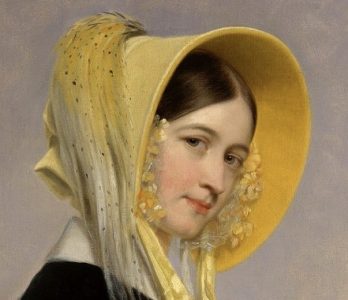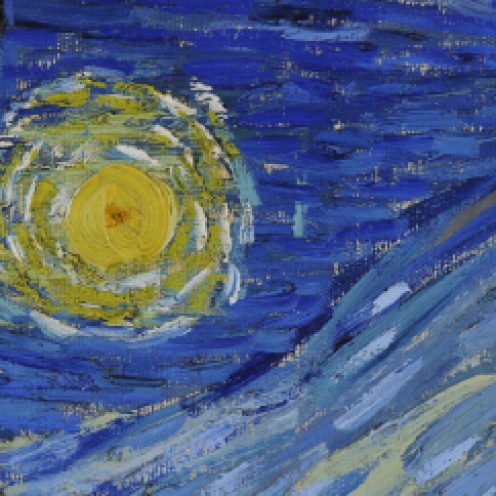
Preface
- See previous posts for detailed images of The Olive Trees and The Starry Night.
- Note that Olive Trees with the Alpilles in the Background is also called The Olive Trees
- Vincent van Gogh painted at least 18 paintings of olive trees, but only one –The Olive Trees — was a complement to The Starry Night.
- Both paintings on view: The Museum of Modern Art, New York, Floor 5, Collection Gallery
The Tale Begins: Saint-Rémy (May 1889 – May 1890)
From letters written in 1889 between the van Gogh brothers, we can decipher the story behind two of Vincent’s most famous paintings, The Starry Night and The Olive Trees. Vincent sent both paintings to Theo, along with many letters containing details of his thoughts and influences during that time.
The Asylum
In the aftermath of the 23 December 1888 breakdown that resulted in the self-mutilation of his left ear, Vincent voluntarily admitted himself to an asylum in Saint-Remy, France. Van Gogh had two cells with barred windows, one of which was he used as a studio.[162] The clinic and its garden became the main subjects of his paintings. He was allowed short supervised walks, during which time he painted cypresses and olive trees.(source: wikipedia)
During the year van Gogh stayed at the asylum, his prolific output of paintings that had begun in Arles continued. In the spring of 1889, Vincent van Gogh wrote to his brother Theo,
“I did a landscape with olive trees
and also a new study of a starry sky.”

The Influence of Nature
Van Gogh found respite from his illness in interaction with nature. In 1889, he was suffering symptoms of mental illness, yet the series of olive tree paintings are considered to be among his finest works. (source: wikipedia)
Among the blossoming trees, the olive orchards and fields, van Gogh most often found “profound meaning”, because he saw in their cycles an analogy to human life. He wrote to Theo that death, happiness and unhappiness are “necessary and useful” and relative, declaring, “Even faced with an illness that breaks me up and frightens me, that belief is unshaken.”[8]

The Olive Trees
Van Gogh found that painting olive trees was both “demanding and compelling.” Vincent wrote to Theo that he was “struggling to catch (the olive trees). They are old silver, sometimes with more blue in them, sometimes greenish, bronzed, fading white above a soil which is yellow, pink, violet tinted orange… very difficult.” He found that the “rustle of the olive grove has something very secret in it, and immensely old. It is too beautiful for us to dare to paint it or to be able to imagine it.“[10] (source: wikipedia)
… the “rustle of the olive grove has something very secret in it, and immensely old. It is too beautiful for us to dare to paint it or to be able to imagine it.”[10]
Vincent van Gogh
According to the Museum of Modern Art, New-York:
“In the blazing heat of this Mediterranean afternoon, nothing rests. Against a ground scored as if by some invisible torrent, intense green olive trees twist and crimp, capped by the rolling, dwindling hillocks of the distant Alps, beneath a light-washed sky with a bundled, ectoplasmic cloud.”
Publication excerpt from The Museum of Modern Art, MoMA Highlights, New York: The Museum of Modern Art, revised 2004, originally published 1999, p. 34.

The Divine
Van Gogh captured the colors and moods of the trees which varied dramatically by daylight and season.[12] He began to use the color blue to represent the divine. In both The Starry Night and his olive tree paintings, van Gogh used the intense blue of the sky to symbolize the “divine and infinite presence” of Jesus. Seeking a “modern artistic language” to represent the divine, he sought a numinous quality in many of his olive tree paintings, such as by bathing olive trees, an emblem for Jesus, in “radiant gold light“.[25] (wikipedia)
Skye Jethani, author of The Divine Commodity: Discovering a Faith Beyond Consumer Christianity, …(in) the olive tree series in particular, van Gogh conveys the redemptive quality of sorrow and that even in sorrow, there can be rejoicing.(wikipedia)
To quote van Gogh’s sermon of 1876:
“Sorrow is better than joy… for by the sadness of the countenance, the heart is made better. Our nature is sorrowful, but for those who have learnt and are learning to look at Jesus Christ, there will always be reason to rejoice. It is a good word, that of St. Paul: as being sorrowful yet also rejoicing.”[27] (source: wikipedia)
“This morning I saw the country from my window a long time before sunrise, with nothing but the morning star, which looked very big,” van Gogh wrote to his brother Theo, from France.
“Rooted in imagination and memory, The Starry Night embodies an inner, subjective expression of van Gogh’s response to nature. In thick, sweeping brushstrokes, a flamelike cypress unites the churning sky and the quiet village below. The village was partly invented, and the church spire evokes van Gogh’s native land, the Netherlands.” MOMA Gallery label from 2011.
The View
Although The Starry Night was painted during the day in Van Gogh’s ground-floor studio, it would be inaccurate to state that the picture was painted from memory. The view has been identified as the one from his bedroom window, facing east,(source wikipedia)
Van Gogh depicted the view at different times of day and under various weather conditions, including sunrise, moonrise, sunshine-filled days, overcast days, windy days, and one day with rain. While the hospital staff did not allow Van Gogh to paint in his bedroom, he was able there to make sketches in ink or charcoal on paper; eventually he would base newer variations on previous versions. The pictorial element uniting all of these paintings is the diagonal line coming in from the right depicting the low rolling hills of the Alpilles mountains. (source wikipedia)
Click for enlarged view:
“Through the iron-barred window, I can see an enclosed square of wheat . . . above which, in the morning, I watch the sun rise in all its glory.”
Vincent van Gogh to brother, Theo, around 23 May 1889
Click for enlarged view:
“This morning I saw the country from my window a long time before sunrise, with nothing but the morning star, which looked very big,”
MOMA Highlights further clarified:
“This morning star, or Venus, may be the large white star just left of center in The Starry Night. The hamlet, on the other hand, is invented, and the church spire evokes van Gogh’s native land, the Netherlands. The painting, like its daytime companion, The Olive Trees, is rooted in imagination and memory. Leaving behind the Impressionist doctrine of truth to nature in favor of restless feeling and intense color, as in this highly charged picture, van Gogh made his work a touchstone for all subsequent Expressionist painting.”
Publication excerpt from The Museum of Modern Art, MoMA Highlights, New York: The Museum of Modern Art, revised 2004, originally published 1999, p. 35.
The Significance
The Museum of Modern Art, New-York, about The Starry Night:
“Why, I ask myself, shouldn’t the shining dots of the sky be as accessible as the black dots on the map of France? Just as we take the train to get to Tarascon or Rouen, we take death to reach a star.”
Vincent sent The Olive Trees and The Starry Night to Theo, saying,
“The olive trees with the white cloud and the mountains behind, as well as the rise of the moon and the night effect, are exaggerations from the point of view of the general arrangement; the outlines are accentuated as in some old woodcuts.”
The Legacy
Though his work is acclaimed today, in his lifetime, Van Gogh created 900 paintings and made 1,100 drawings and sketches, but only sold one painting during his career.(source: The Art Story)
Curiously, Van Gogh calls The Starry Night a failure for being an “abstraction,” and he places the blame on his having painted “stars that are too big.” Now regarded as among Van Gogh’s finest works, The Starry Night is one of the most recognized paintings in the history of Western culture. {Vincent’s} intention was to go beyond “the photographic and silly perfection of some painters” to an intensity born of color and linear rhythms.[30]
According to The Art Story,
“Evocative of the spirituality Van Gogh found in nature, Starry Night is famous for advancing the act of painting beyond the representation of the physical world.”
“Vincent van Gogh Biography, Art, and Analysis of Works”. The Art Story.
“Van Gogh used an impulsive, gestural application of paint and symbolic colors to express subjective emotions. These methods and practice came to define many subsequent modern movements from Fauvism to Abstract Expressionism.”
“Vincent van Gogh Biography, Art, and Analysis of Works”. The Art Story.

The Summary
Of “Olive Trees in a Mountainous Landscape” in the collection of the Museum of Modern Art (MoMA), Vincent wrote his brother Theo: “I did a landscape with olive trees and also a new study of a starry sky,” calling this painting the daylight complement to the nocturnal, The Starry Night. His intention was to go beyond “the photographic and silly perfection of some painters” to an intensity born of color and linear rhythms.[30]
According to the Museum of Modern Art,
“Leaving behind the Impressionist doctrine of truth to nature in favor of restless feeling and intense color, as in this highly charged picture, van Gogh made his work a touchstone for all subsequent Expressionist painting.”
excerpt from The Museum of Modern Art, MoMA Highlights, New York: The Museum of Modern Art, revised 2004, originally published 1999, p. 35
The End
References
The Museum of Modern Art, The Olive Trees, Web. May 23, 2018, https://www.moma.org/collection/works/80013?locale=en&location_id=38&page=1&sov_referrer=location
The Museum of Modern Art, The Starry Night, Web. May, 23, 2018, https://www.moma.org/collection/works/79802?artist_id=2206&locale=en&page=1&sov_referrer=artist
Publication excerpt from The Museum of Modern Art, MoMA Highlights, New York: The Museum of Modern Art, revised 2004, originally published 1999, p. 34.
Publication excerpt from The Museum of Modern Art, MoMA Highlights, New York: The Museum of Modern Art, revised 2004, originally published 1999, p. 35.
Art-vangogh.com accessed online May 23, 3018. http://art-vangogh.com/
Wikipedia contributors, “The Starry Night,” Wikipedia, The Free Encyclopedia, https://en.wikipedia.org/w/index.php?title=The_Starry_Night&oldid=842761449 (accessed May 25, 2018).
Wikipedia contributors, “Vincent van Gogh,” Wikipedia, The Free Encyclopedia, https://en.wikipedia.org/w/index.php?title=Vincent_van_Gogh&oldid=840778324 (accessed May 25, 2018).
Wikipedia contributors, “Olive Trees (Van Gogh series),” Wikipedia, The Free Encyclopedia, https://en.wikipedia.org/w/index.php?title=Olive_Trees_(Van_Gogh_series)&oldid=842710481 (accessed May 25, 2018).
Google Arts and Culture, “The Starry Night”, Web. 25 May 2018, https://artsandculture.google.com/asset/the-starry-night/bgEuwDxel93-Pg
The Art Story, “Vincent van Gogh Biography, Art, and Analysis of Works”(accessed 25 May 2018).








One Comment Add yours